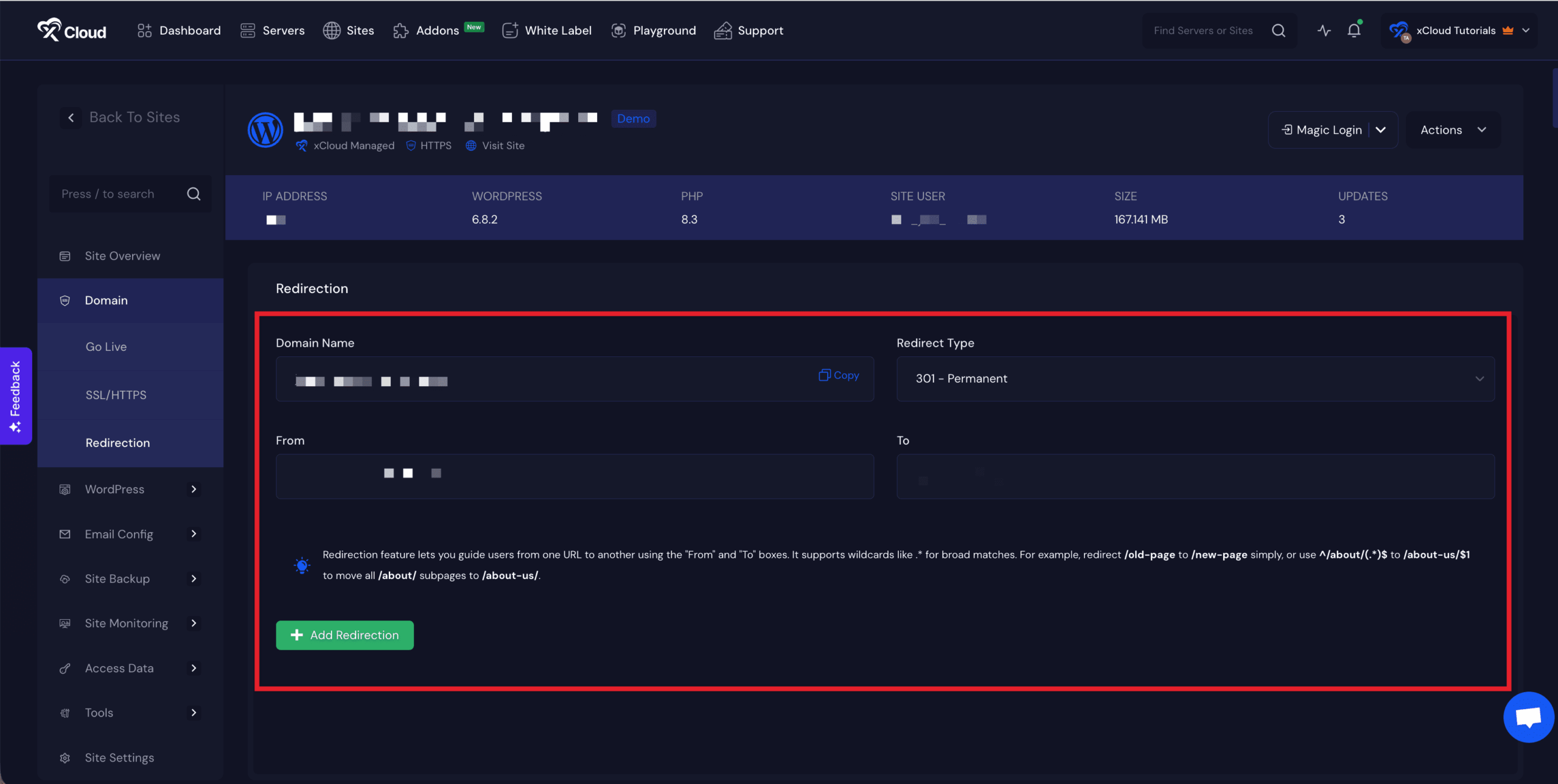When you move or restructure pages on your website, setting up proper redirects is crucial. Without them, you risk losing valuable search engine rankings and creating a frustrating experience for your visitors. A redirect not only guides users to the right content but also signals to search engines that your page has moved, preserving your site’s link authority.

Incorrectly configured redirects can lead to broken links, drops in rankings, or indexing issues. You will often need redirects when removing outdated content, merging pages, changing domains, or switching to HTTPS.
In this guide, we will deep dive into the types of redirects, how to redirect a URL to another URL, and best practices to ensure your URL changes do not negatively impact your SEO.
What is a URL Redirect?
A URL redirect is a method that automatically sends both users and search engines from one web address to another. Instead of showing a 404 error when a page is no longer available, a redirect ensures visitors land on the correct page.
Technically, a URL redirect is a rule or instruction telling browsers and search engines to forward traffic from an old URL (the original address) to a new URL (the updated or destination address). When implemented correctly, redirects prevent broken links, maintain user experience, and preserve SEO value.
Redirects are particularly helpful when you need to:
- Change a page’s URL or update its slug, ensuring the URLensuring URL structure is clean and SEO-friendlySEO-friendly URL.
- Move your website to a new domain.
- Remove obsolete content.
- Rebrand and migrate to a new domain.
- Switch from HTTP to HTTPS for improved security.
- Consolidate duplicate pages into a single, authoritative page.
Without redirects, these changes could result in errors, confuse visitors, and negatively affect your search engine rankings. Properly set up redirects ensure a seamless transition for both users and search engines.
How Does a URL Redirect Work?
When someone clicks a link that has a redirect, several processes happen behind the scenes to ensure the user reaches the correct page:
- The browser sends a request to the server for the original URL.
- The server checks its rules and determines that the URL should be redirected.
- The server responds with an HTTP status code or redirect status code (such as 301, 302, or 307) along with the destination URL.
- The browser automatically requests the new URL.
- The user is taken to the correct page without having to take any additional action.

From a search engine perspective, the type of redirect is crucial. Permanent redirects (like 301) signal that the page has moved permanently, allowing link equity to transfer to the new page. Temporary redirects (like 302) indicate a short-term change, which may not pass on the same SEO value. Choosing the right redirect method ensures both users and search engines understand the nature of the move and preserves SEO authority.
Use Cases for Redirecting a URL to Another URL
Redirects are not only a tool for user experience, they also help preserve SEO authority when content moves or changes. Implementing redirects in the right situations allows the new page to retain some of the ranking power of the original. Here are the most common use cases:
Vanity URLs

Vanity URLs are short, memorable web addresses often used in marketing campaigns. For instance, a TV advertisement might direct viewers to www.example.com, which redirects to a longer URL like www.example.com/test/demo. Vanity URLs make it easy for users to remember and access a page without disrupting your main website structure.
Migrating Content
During a website structure update or restructure, content may be moved between subfolders, subdomains, or sections. Redirects maintain accessibility for both users and search engines, ensuring a smooth experience while preserving SEO authority and avoiding duplicate or conflicting canonical content. In some cases, a masked redirect can be used to display the original URL in the browser while forwarding users to a different page.
Domain Changes
Redirects, or domain forwarding, are essential when migrating to a new domain, whether due to rebranding, restructuring, acquiring another site, or splitting content across multiple domains. They help ensure the correct canonical URL is recognized by search engines. Correctly implemented redirects help maintain search engine rankings by pointing all old URLs to their new counterparts.
URL Rewrites
Sometimes URLs need updating after going live, correcting typos, changing a product name, or updating a date in the URL. Redirecting the old URL to the new one ensures visitors and search engines can still find the correct page without encountering errors.
HTTP to HTTPS Migration
Even though HTTPS is now standard, some websites may still need to switch from HTTP. Implementing redirects across the entire site ensures that visitors reach the secure version of each page, while preserving SEO value and preventing duplicate content issues.
In every scenario, careful use of redirects ensures that visitors land on the correct pages and that search engines continue to recognize and pass on ranking authority, keeping both user experience and SEO intact.
What Are the Types of Redirects and What Are They For?
Redirects come in different types, each serving a specific purpose. They are an essential part of website management, especially during migrations, content restructuring, or temporary updates. Choosing the right type of redirect ensures both users and search engines understand the nature of the move and maintain proper positioning in search engine results.
Broadly, redirects are categorized into two main types: server-side redirects, handled by the web server before the page loads, and client-side redirects, executed in the user’s browser after the page loads.
Server-Side Redirects
A server-side redirect, also known as an HTTP redirect or server header response, is processed on the server before any content reaches the user’s browser. When a user requests a URL, the server checks for a redirection rule. If one exists, it sends an HTTP response with a status code (usually 301 or 302) indicating that the resource has been moved. The browser then requests the new URL automatically.
1. 301 Redirect (Permanent)
A 301 (permanent) redirect signals that a page has permanently moved and transfers most of the link equity to the new URL. It is commonly used when:
- Moving a website to a new domain
- Changing page URLs
- Consolidating duplicate content
From an SEO perspective, 301 redirects are highly valuable because they transfer most of the link authority from the old URL to the new one. Over time, search engines replace the old URL in their index, helping maintain rankings and traffic.
2. 302 Redirect (Temporary)
A 302 redirect indicates a temporary move. It is useful for:
- Seasonal promotions
- A/B testing
- Brief page updates
Search engines usually keep the original page indexed and may not transfer full authority to the new page. Leaving a 302 redirect active for too long can confuse search engines and may eventually be treated as permanent.
3. 307 Redirect (Temporary with Request Method Preservation)
A 307 redirect is also temporary but ensures the same request method (GET or POST) is preserved. This is especially important for forms or applications where request types matter. SEO-wise, it behaves like a 302 redirect and should only be used for short-term needs.
Client-Side Redirects
Client-side redirects happen after a page has loaded in the user’s browser, typically using JavaScript or HTML meta refresh tags. These redirects do not involve server communication.
4. Meta Refresh Redirect
A meta refresh redirect is embedded in the HTML and often comes with a delay, for example: “You will be redirected in 5 seconds.” While it works, this method is not SEO-friendly. Search engines may not treat it as a proper redirect, and delays can frustrate users. Meta refresh redirects are generally discouraged and should only be used when server-side options are unavailable.
5. JavaScript Redirect
A JavaScript redirect uses code executed in the user’s browser to forward them to another page. It can also support Geo-location Redirects, sending users to region-specific content based on their location. This method can be useful when server-side access is unavailable or when conditional redirects are needed (for example, redirecting users based on device or location). Modern search engines can process JavaScript redirects, but they are less reliable than server-side methods. Scripts can fail, which may lead to crawling and indexing issues.

Meta refresh and JavaScript redirects should only be used as a last resort when server-side options are not possible. By carefully selecting the appropriate redirect type, you ensure your website transitions seamlessly without losing visibility in search results.
Choosing the right type of redirect is essential for both SEO ranking and a smooth user experience. Permanent redirects like 301 help maintain link authority, while temporary redirects such as 302 and 307 are best for short-term changes.
How to Redirect a Domain to Another Domain: 3 Ways
Understanding the types of redirects and proper URL Redirecting is just the first step. To redirect a URL to another URL without affecting search engine rankings, you also need to know how to implement it correctly on your website. The method you choose will depend on your hosting environment, server type, or content management system.
Method 1: Redirect a URL Using a WordPress Plugin
For websites built on WordPress, the world’s most popular content management system, redirect plugins make managing URL changes simple and efficient. Plugins like Simple 301 Redirection allow you to set up 301 redirects directly from your dashboard without editing server files.
Another powerful option is BetterLinks, which enables you to manage 301, 302, and other redirects directly from the WordPress dashboard. With BetterLinks, you can set up redirects quickly, track clicks and analytics, handle URL changes efficiently, and ensure that your redirects remain SEO-friendly. Using a reliable plugin is especially helpful for site owners who prefer a user-friendly interface over manual configuration. For non-technical users, plugins provide a safe and fast way to redirect a URL to another URL with the correct redirect type without touching any code.
Method 2: Using the .htaccess File to Redirect a URL to Another URL
For advanced redirects, the .htaccess file provides unmatched flexibility and control. This method allows you to implement complex redirect rules, manage multiple redirects simultaneously, and even set conditions based on specific URL patterns or user agents.
To set it up in xCloud, start by opening the File Manager in your dashboard. Navigate to Access Details → File Manager and click Launch File Manager. Once the File Manager opens, go to the public_html directory and double-click the .htaccess file to edit it.
Add the following rules below the RewriteEngine On line to configure a permanent 301 redirect:
RewriteCond %{HTTP_HOST} ^mydomain.com [NC,OR]
RewriteCond %{HTTP_HOST} ^www\.mydomain\.com$ [NC]
RewriteRule ^(.*)$ https://targetdomain.com/$1 [L,R=301,NC]Be sure to replace mydomain.com and targetdomain.com with your actual domain names. If you want a temporary redirect, change R=301 to R=302. After adding the rules, save the file to apply the changes.
This method is ideal for website owners who need full control over redirects and prefer managing them at the server level. For a complete step-by-step guide on using .htaccess in xCloud, consult the detailed documentation.
Method 3: Set Up a URL Redirect via Your Hosting Panel
xCloud also allows you to set up redirects directly through your hosting panel, which makes forwarding traffic from one URL to another quick and straightforward. This method helps prevent traffic loss and downtime when moving content to a new page or updating a permalink.
xCloud supports two types of redirects: 301 (Permanent), which informs search engines to update their indexes, and 302 (Temporary), which indicates that the content may return to its original URL.
To set up a redirect, first navigate to Domain → Redirection in your site dashboard. On the Redirection tab, select the type of redirect you want to use (301 or 302) and enter the old URL in the “From URL” field and the new destination in the “To URL” field. For example, to create a 301 redirect, select 301 as the redirect type, set the From URL as /test and the To URL as /demo, then click Add Redirection. The old URL will now automatically forward visitors to the new page.

You can add multiple redirects for the same domain, and all active redirects will be displayed for easy management. For a detailed, step-by-step process on setting up redirects in xCloud, refer to the full documentation.
Testing & Verifying That Your Redirect Works Properly
After setting up a domain redirect, testing is essential to ensure it functions correctly. Start by entering your old URL in multiple browsers and on different devices to confirm it forwards to the new destination. There are many URL redirect checker tools, such as What’s My DNS or WhereGoes, to check if the redirect is working across various locations worldwide.
If the redirect is not working as expected, try the following troubleshooting tips:
- Check the redirect type: Make sure you are using the correct redirect. A 301 redirect is permanent and transfers most SEO authority to the new URL, while a 302 redirect is temporary and does not pass full link equity. If the wrong type was used, remove the old redirect and set up the correct one.
- Clear browser cache and cookies: Browsers may store cached versions of pages or old redirect rules. Clearing the cache ensures you are seeing the latest version of your site.
- Verify DNS propagation: DNS changes can take 24 – 48 hours to propagate worldwide. Use a DNS checker tool to confirm that the updated records are live.
- Check for typos or incorrect settings: Ensure the old URL exactly matches the source URL in your redirect configuration, and the target URL is correct. Even small mistakes can break the redirect.
- Review SSL and HTTPS settings: If your site uses HTTPS, confirm that both old and new URLs have valid SSL certificates. A mismatch can prevent the redirect from functioning.
- Look for conflicting redirects or loops: Multiple redirects pointing to different URLs, or loops where the old URL redirects back to itself, can cause errors like “too many redirects.” Audit your redirect rules to avoid conflicts.
- Test query parameters and subpages: If your old domain had additional parameters or subpages, make sure they redirect correctly to the corresponding new pages. Wildcard redirects may be needed to cover multiple paths.
13 Best SEO Practices for Redirecting a URL
Properly setting up redirects is key to preserving your SEO value and giving users a smooth browsing experience. Here are some essential practices to ensure your redirects are working properly without affecting search performance.
1. Redirect Outdated Content to Updated Pages
When content becomes outdated or irrelevant, redirect it to a new page with fresh, accurate information. This ensures both users and search engines can find the most relevant content without running into dead links. For example, if a blog post moves to a new URL, use a 301 redirect from the old page to the new one to preserve traffic and SEO authority.
2. Domain Migration From HTTP or HTTPS Transition
One of the most sensitive times for SEO is when you move an entire website to a new domain or shift from HTTP to HTTPS. In both situations, the only safe solution is to use permanent 301 redirects across all affected pages. This ensures that search engines transfer ranking signals from the old URLs to the new ones. This not only protects your site but also maintains link equity, as Google prefers HTTPS pages and ranks them higher.
3. Consolidate Similar or Duplicate Pages
If your site has multiple pages with overlapping content, redirect the less important pages to the primary one. This prevents duplicate content issues, organizes your site better, and helps concentrate SEO value on the main page.
4. Avoid Redirect Chains and Loops
Keep redirects straightforward. Chains, where one URL redirects to another and then another, slow down your site and dilute SEO value. Redirect loops, where a URL points back to itself, create errors and block access. Always point the old URL directly to the final destination for clarity and efficiency.
5. Fix broken redirects
A redirect that leads to a non-existent page frustrates users and hurts SEO. Regularly check your redirects across each web property with tools like Google Search Console to ensure all URLs lead to valid pages.
6. Redirect 404 Pages to Useful Content
Instead of leaving visitors on a 404 page, redirect them to a relevant page or a well-designed custom 404 page with helpful links. This reduces bounce rates and improves user experience. Tools like the Ahrefs Broken Links Checker SEO extension can help you quickly identify broken links.
7. Update Internal Links
Make sure internal links point directly to the new URLs instead of relying on redirects. This improves site speed, user experience, and SEO performance.
8. Do Not Redirect All Pages To the Homepage
Redirecting many pages to your homepage can frustrate users and lower your relevance in search results. Always redirect to the most relevant page to maintain SEO value and help users find what they need.
9. Remove Redirected URLs from Your Sitemap
Once a URL is redirected, remove it from your sitemap. This prevents search engines from crawling outdated pages and keeps your indexing clean.
10. Keep Redirects in Place for At Least a Year
You should keep 301 redirects in place for at least one year to ensure that Google and other search engines have sufficient time to process the permanent page move and pass all relevant ranking signals to the new URL. A minimum one-year duration allows Google to recrawl and reassign links, making the redirect permanent in their systems and preventing loss of traffic and SEO value.
11. Redirect Other File Types Too
Redirects are not just for web pages; they should also cover files like PDFs, images, and other media that have moved. Make sure everything points to its new location.
12. Using URL Shorteners That Preserve SEO
URL shorteners are often used in social media campaigns, email marketing, affiliate marketing and print advertising. However, some use temporary redirects, which do not pass SEO value, while others rely on permanent 301 redirects that preserve ranking signals.
If you rely on shorteners for sharing links, always choose a provider that uses 301 redirects. This way, any authority gained from backlinks pointing to the short link will still flow through to your main website.
13. Avoiding Black-Hat Practices
Not all redirects are created with good intentions. Some webmasters try to trick search engines by using deceptive redirects, such as doorway pages or cloaking. These tactics involve showing search engines one version of a page while sending users to a different destination. Although they may produce short-term gains, search engines are quick to detect them and often issue severe penalties.
Redirect URL While Preserving SEO Performance of Your Site
Redirecting URLs is an essential part of website management that ensures visitors reach the correct pages while maintaining search engine optimization (SEO) and visibility. Properly implemented redirects prevent broken links, maintain user experience, and help retain SEO value when making changes such as moving content, updating domains, or switching to HTTPS. Using the right methods and following best practices, you can manage URL changes effectively and keep your website running smoothly.
Frequently Asked Questions
1. What is a URL redirect?
A URL redirect is a technique used to forward visitors and search engines from one URL to another. It’s commonly employed when a webpage has been moved or deleted, ensuring users and search engines are directed to the correct location.
2. Which type of redirect should I use to preserve SEO value?
To maintain SEO value, you should use a 301 redirect, which indicates that the original page has permanently moved to a new location. This type of redirect passes most of the original page’s link equity to the new URL.
3. Can I use a 302 redirect instead of a 301?
A 302 redirect is temporary and tells search engines that the move is not permanent. While it can be useful in certain situations, it doesn’t pass as much link equity as a 301 redirect. For permanent changes, a 301 redirect is recommended.
4. How do redirects affect my site’s SEO?
Properly implemented redirects, especially 301 redirects, help preserve your site’s SEO by transferring most of the original page’s ranking power to the new URL. However, improper implementation can lead to issues like loss of link equity or traffic.
5. Should I update internal links after setting up redirects?
Yes, it is important to update internal links to point directly to the new URL. This reduces reliance on redirects and ensures a smoother user experience and better crawl efficiency for search engines.
6. What is a redirect chain, and why should I avoid it?
A redirect chain occurs when a URL redirects to another URL, which in turn redirects to another, and so on. This can dilute link equity and slow down page load times, negatively impacting SEO. It’s best to have a direct redirect from the old URL to the new one.
7. Can redirect loops harm my site’s SEO?
Yes, a redirect loop happens when a URL redirects to itself, either directly or indirectly. This creates an infinite loop that can prevent search engines from accessing your content, leading to indexing issues and potential penalties.
8. Is it necessary to use a 301 redirect when changing domains?
Yes, when changing domains, it is crucial to implement 301 redirects from the old domain’s URLs to the corresponding URLs on the new domain. This helps maintain SEO rankings and ensures users are directed to the correct pages.
9. How can I monitor the effectiveness of my redirects?
You can monitor redirects using tools like Google Search Console, which provides information on crawl errors and redirect issues. Additionally, analytics tools can help track traffic patterns and identify any drops that may indicate redirect problems.
10. Are there any risks associated with improper redirect implementation?
Yes, improper redirect implementation can lead to issues such as loss of link equity, traffic drops, and indexing problems. It is important to carefully plan and test redirects to ensure they are set up correctly and do not negatively impact SEO.
If you have found this blog helpful, feel free to subscribe to our blogs for valuable tutorials, guides, knowledge, and tips on web hosting and server management. You can also join our Facebook community to share insights and engage in discussions.







































